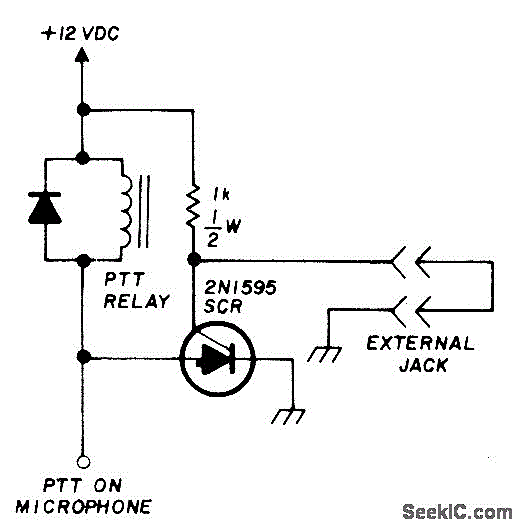
SCR_LATCH

Activates a mobile transceiver or other mobile equipment when power is applied, especially if the external circuit is interrupted during theft. The transmitter will then emit an unmodulated carrier signal even if the Push-To-Talk (PTT) switch is disconnected or turned off, allowing for tracing with a radio direction finder. If additional components are discreetly integrated into the equipment and new external wiring is properly implemented, this functionality can be enhanced.
This circuit is designed to ensure that mobile communication equipment remains operational and traceable in the event of theft. The activation mechanism is triggered by the application of power, which can be sourced from the vehicle's battery or an external power supply. The core functionality relies on a simple relay or transistor switch that detects the presence of power and engages the transmitter.
The transmitter is configured to output an unmodulated carrier wave, which is a continuous wave signal without any modulation. This signal is crucial for radio direction finding, as it allows tracking devices to pinpoint the location of the stolen equipment. The design includes a method for bypassing the PTT switch, ensuring that the transmitter remains active regardless of the operational state of the switch. This is typically achieved through a secondary circuit that maintains the transmitter's operation independent of user controls.
Incorporating additional components requires careful planning to avoid detection by potential thieves. This may involve using surface-mounted devices (SMDs) that can be hidden within the existing circuitry of the equipment. Moreover, the external wiring should be integrated in such a way that it does not attract attention, possibly by routing it through existing conduits or harnesses.
For optimal performance, the circuit may include features such as a low-power consumption mode to extend battery life and a timing mechanism that activates the transmitter only after a certain delay, preventing immediate detection during the initial theft. The design should also account for the frequency band used for transmission, ensuring compliance with local regulations regarding unlicensed transmission.
Overall, this circuit serves as a valuable security enhancement for mobile transceivers, providing a means to recover stolen equipment and deter theft through its covert operation.Turns on mobile transceiver or other mobile equipmentwhen powerisapplied, if external circuit is broken when equipment is stolen. Transmitter will then put unmodulated carrier on air even with PTT switch disconnected or off, for tracing with radio direction finder.
If added components are carefully concealed in equipment and new external wiring is worked int.. 🔗 External reference
This circuit is designed to ensure that mobile communication equipment remains operational and traceable in the event of theft. The activation mechanism is triggered by the application of power, which can be sourced from the vehicle's battery or an external power supply. The core functionality relies on a simple relay or transistor switch that detects the presence of power and engages the transmitter.
The transmitter is configured to output an unmodulated carrier wave, which is a continuous wave signal without any modulation. This signal is crucial for radio direction finding, as it allows tracking devices to pinpoint the location of the stolen equipment. The design includes a method for bypassing the PTT switch, ensuring that the transmitter remains active regardless of the operational state of the switch. This is typically achieved through a secondary circuit that maintains the transmitter's operation independent of user controls.
Incorporating additional components requires careful planning to avoid detection by potential thieves. This may involve using surface-mounted devices (SMDs) that can be hidden within the existing circuitry of the equipment. Moreover, the external wiring should be integrated in such a way that it does not attract attention, possibly by routing it through existing conduits or harnesses.
For optimal performance, the circuit may include features such as a low-power consumption mode to extend battery life and a timing mechanism that activates the transmitter only after a certain delay, preventing immediate detection during the initial theft. The design should also account for the frequency band used for transmission, ensuring compliance with local regulations regarding unlicensed transmission.
Overall, this circuit serves as a valuable security enhancement for mobile transceivers, providing a means to recover stolen equipment and deter theft through its covert operation.Turns on mobile transceiver or other mobile equipmentwhen powerisapplied, if external circuit is broken when equipment is stolen. Transmitter will then put unmodulated carrier on air even with PTT switch disconnected or off, for tracing with radio direction finder.
If added components are carefully concealed in equipment and new external wiring is worked int.. 🔗 External reference